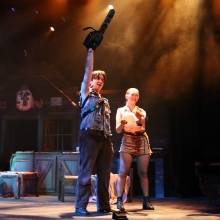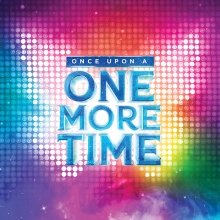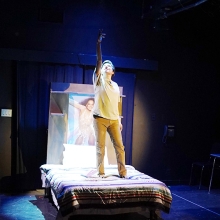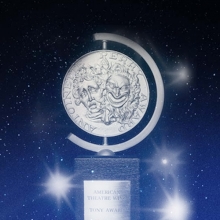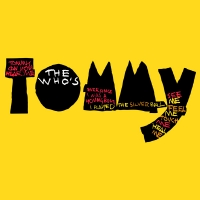
Full Synopsis
Act One
A slide projects the date: 1940. The Prologue begins with Captain Walker, a handsome English officer in his mid-twenties, waiting as his plane is being fueled. Walker tries to get the attention of a masked Welder who is working nearby. After a few unsuccessful attempts, Walker taps the Welder's back. The Welder removes the mask; the Welder is a woman. Walker offers her a cigarette, which she accepts before walking away. He follows her. Using World War II in London as a backdrop, the Prologue continues to chronicle Captain Walker and Mrs. Walker's marriage, then Captain Walker's deployment to parachute into Germany ("Overture"). The Prologue ends with two German foot soldiers firing their machine guns at Captain Walker.
A slide announces the location: London. Uncle Ernie appears and knocks on the front door of the Walker house; he presents the pregnant Mrs. Walker with sardines, eggs, milk – all contraband food items. She thanks him and, as he leaves, he runs into two officers who are approaching the house. The officers tell Mrs. Walker that Captain Walker is missing and they don't expect to find him ("It's a Boy"). Mrs. Walker takes the official papers from one of the officers and steps back into the house, closing the door. The officers see Ernie and hand him a bottle of whiskey as they leave. Ernie slowly opens the bottle and takes a quick drink. He stands uncomfortable, alone. He reopens the bottle and takes a longer drink; the doorway to the Walker's house disappears, and Ernie is left alone onstage. A section of barbed wire appears, and a German guard pushes along a line of Allied prisoners, including Walker.
A slide announces the date: 1941. Walker, seen in silhouette, paces back and forth. Uncle Ernie puts away the whiskey bottle as a Nurse pushes Mrs. Walker in a wheelchair. Another Nurse enters holding a small bundle, a baby boy, which she gives to Mrs. Walker ("It's a Boy – Part 2"). As Ernie continues swigging from the whiskey bottle, slides announce the passing years: 1942, 1943, 1944; we continue to see Walker pace back and forth. After a slide announces: 1945, Allied soldiers enter the complex in which Walker is kept. One of the soldiers leads Walker away, telling him that the Allies have won the war.
Inside the Walker home, Mrs. Walker, her lover and Four-Year-Old Tommy are preparing to celebrate her 21st birthday: a cake with 21 candles, a bottle of champagne and two glasses sit on a table in the living room. The room also has a large wardrobe with a full-length mirror on its face. The lover, dressed in a t-shirt and trousers with suspenders, watches tenderly as Mrs. Walker blows out the candles and cuts the cake. Both express the hope that the coming year will be a good one ("Twenty-One"). Mrs. Walker puts the boy in bed and enters the living room to join her lover. Captain Walker, accompanied by two officers, approaches the front door of the Walker house. After the officers leave, Walker enters as Mrs. Walker and the lover embrace. When Mrs. Walker moves to touch Walker, the lover pushes Walker back toward the door, which precipitates a fight and awakens Four-Year-Old Tommy. The boy enters the room, and Mrs. Walker turns him toward the mirror, thinking that this will keep him from witnessing the scene. The lover and Walker continue fighting. When Mrs. Walker tries to separate the men, the lover slaps her; he picks up a chair to throw at Walker. Walker, enraged, pulls out and fires his revolver, hitting the lover in the head and killing him. After Walker lowers the gun, they notice Tommy, who has watched it all in the mirror. They hysterically tell Tommy, who is still facing the mirror, that he hasn't seen or heard anything, and they demand that he never tell a soul what happened.
The police arrive as Mrs. Walker assures Tommy that everything will be alright. Tommy doesn't respond to her questions and continues to stare into the mirror; the room takes on an unreal quality – doors take new positions, chairs fly through the air. As the police question Mr. and Mrs. Walker and military policemen arrive, the Narrator – or Adult Tommy – flies down. He will be Four-Year-Old Tommy's guide, even as the young boy's mind is occupied with recording everything that it sees and hears ("Amazing Journey"). Uncle Ernie enters and tries to embrace his brother, but is held back by a policeman. After taking another drink, Ernie puts his arm around young Tommy, who is still staring into the mirror. The Narrator vanishes as the house disappears.
Captain Walker, in uniform, is standing in court before a Judge and Barristers. The Judge pronounces the Captain "Not Guilty" of murder, and Mrs. Walker and Uncle Ernie celebrate the finding with the rest of the courtroom. When the Judge addresses Four-Year-Old Tommy, we hear what Tommy hears: the language becomes unintelligible and he stares straight ahead. Tommy's parents realize what they may have done to him.
Tommy is taken to a hospital, where he is rushed from room to room for a series of tests and evaluations. A Young Doctor delivers Tommy to a Nurse, who takes his pulse and gets a urine sample as another Doctor waits nearby; another Nurse checks his reflexes and takes blood; a Doctor unbuttons his shirt and listens to his heartbeat; another Doctor looks into his eyes and ears. After studying Tommy's charts, a Doctor addresses the Walkers, shaking his head. The Walkers go away, leaving Tommy with the Doctors ("Sparks").
A slide announces: 1950. Ten-Year-Old Tommy, a balloon tied to his wrist, appears with a Nurse to meet his parents. The Narrator floats down ("Amazing Journey – Reprise"), takes the balloon from the boy and floats away with it.
The Walker family – including Ten-Year-Old Tommy, Mr. and Mrs. Walker, Uncle Ernie, Cousin Kevin and other relatives – attend church at Christmas. The Minister and his wife listen as a choir sings. The family comments that Tommy isn't able to appreciate Christmas ("Christmas"). Although they try to enjoy the party, they can't help but think that Tommy doesn't know that it is Christmas or understand its meaning. Everyone is stunned when Tommy responds to Uncle Ernie's playing the French Horn. Mr. Walker, in a desperate attempt to reach his son, shouts, "Tommy, can you hear me?" multiple times. Older Tommy, only visible to young Tommy, sings to him ("See Me, Feel Me").
Back home, the Walkers worry about whether to leave Tommy with his alcoholic Uncle Ernie ("Do You Think It's Alright"). Once alone with Tommy, Ernie molests him ("Fiddle About").
Tommy's next babysitter, cousin Kevin, bullies and abuses Tommy mercilessly ("Cousin Kevin"). Cousin Kevin and his friends then take Tommy to a youth club, where, to everyone's astonishment, he plays pinball brilliantly ("Sensation"). Encouraged, the Walkers try yet another doctor, a psychiatrist, who tests Tommy without success ("Sparks – Reprise").
A desperate Mr. Walker is approached by The Hawker and Harmonica Player, who promise a miraculous cure for Tommy ("Eyesight to the Blind"). They take Mr. Walker and young Tommy to the Isle of Dogs to find a prostitute called The Gypsy. She tries to convince Mr. Walker to let her spend time alone with Tommy, introducing him to sex and drugs ("Acid Queen"). Mr. Walker, horrified by the Gyspy's methods, snatches the boy and runs away.
The act ends in 1958 as Cousin Kevin and a group of teenagers await 17-year-old Tommy's appearance at the amusement arcade ("Pinball Wizard").
Act Two
It is 1960. Tommy has become the pinball champion and hero of the neighborhood gang ("Underture"). Mr. Walker, still in search of a cure, convinces his wife to try once more ("There's a Doctor I've Found"). They take Tommy to specialists for elaborate tests, but to no avail ("Go to the Mirror / Listening to You"). The doctors discover that Tommy's senses do work but are, for some reason, not processing what he sees or hears, and that no one can free Tommy from his catatonic state... but himself. On the street, a group of local louts surround Tommy and carry him home ("Tommy, Can You Hear Me?").
The Walkers, at their wit's end and considering having Tommy institutionalized, compassionately confront one another ("Believe My Own Eyes"). Tommy stares into the mirror as his mother tries desperately to reach him ("Smash the Mirror"). Out of rage, frustration and desperation, she shatters the mirror into which Tommy continually gazed for years. With the mirror in pieces, Tommy becomes conscious and leaves home ("I'm Free").
From 1961 to 1963, Tommy's cure hits the news ("Miracle Cure"). He is idolized by the public and the press ("Sensation – Reprise"). He begins appearing in stadiums, playing pinball with a helmet that temporarily blinds and deafens him ("I'm Free / Pinball Wizard – Reprise"). Uncle Ernie tries to capitalize on Tommy's newfound stardom by selling Tommy souvenirs in a carnival-like setting ("Tommy's Holiday Camp").
Teenaged Sally Simpson manages to sneak out of her parents' home to attend Tommy's appearance. She gets onstage and tries to touch Tommy but, in the commotion, he unknowingly pushes her off the stage. She falls and is pummeled by the guards ("Sally Simpson"). Tommy, in horror, stops the show and tends to her. Realizing how caught up in the celebrity machine he is, due to the remarkable recovery of his senses, Tommy wishes to do something in return for his fans and invites them all back to his house ("Welcome"). Once there, Sally asks Tommy how she can be more like him ("Sally Simpson's Question"). He is confused and insists that there is no reason for anyone to be like him when everyone else already possesses the gifts that he was deprived of most of his life.
He suddenly realizes that, although he had thought his fame came from his miraculous recovery, in fact, it arose because others hoped that he would assume the role of a kind of spiritual leader, based on his knowledge of what it is like not to hear, see or communicate for so long. Now, disenchanted with their hero for failing to provide the answers that they wanted to be told, the crowd turns on him and leaves ("We're Not Gonna Take It").
Now in despair, Tommy begins hearing the voice of his ten-year-old self and, for a moment (and to the horror of his family), he seems to be reverting to his old state ("See Me, Feel Me – Reprise"). Instead of reverting, he turns to his family, whom he has ignored during his stardom, embraces them in acceptance and reunites with his younger selves ("Listening to You – Reprise"). The entire ensemble joins him and his family on stage. As the curtain falls, we find the Four-Year-Old Tommy, the Ten-Year-Old Tommy and Adult Tommy are left all alone on stage.
Show History
Inspiration
Inspiration for The Who's Tommy was drawn directly from the 1969 concept album, Tommy by the legendary rock band, The Who. The work was the first album in history to be billed overtly as a rock opera and, in its original release, rocketed the band from somewhat-known single artists into what is now regarded as one of the best and best-known rock bands of all time. The album has sold over 20 million copies worldwide and, before being devised as a musical, was also the basis for a 1975 film of the same name. Between the original album, movie and musical, the majority of the plot remains intact, with only slight changes between each.
Productions
The Who's Tommy first premiered on July 1, 1992, at the La Jolla Playhouse in San Diego, California. Acclaimed director, Des McAnuff, and Pete Townshend sculpted the kaleidoscopic concept album by Townshend's former band, The Who (a 1990 inductee into the Rock and Roll Hall of Fame), into a stage show with a story.
Following this premiere, the show then went on to open on Broadway at the historic St. James Theatre on April 22, 1993, and later closed on June 18, 1995, after 899 performances and 27 previews. Directed by Des McAnuff with choreography by Wayne Cilento and additional material by fellow The Who band members, John Entwistle, Keith Moon and Sonny Boy Williamson, the original cast included such names as Michael Cerveris, Marcia Mitzman, Jonathan Dokuchitz and Cheryl Freeman. Alice Ripley, Christian Hoff, Norm Lewis, Paul Kandel, Tracy Nicole Chapman and Sherie Rene Scott rounded out the ensemble.
Following the Broadway run, The Who's Tommy was subsequently mounted in London's West End, Canada and at numerous regional and community theatres throughout the U.S. and internationally.
Cultural Influence
- An original cast recording of The Who's Tommy was produced by RCA Victor and released on July 13, 1993.
Trivia
- The Who's Tommy was among the first Broadway shows to combat high ticket prices by offering enticements such as free CDs, t-shirts and souvenir programs, as well as half-price tickets.
- In 1994, the musical inspired Data East's production of a pinball machine called The Who's Tommy Pinball Wizard, which used music, sound effects and artwork based on the original production.
Critical Reaction
"The Who's Tommy is at long last the authentic rock musical that has eluded Broadway for two generations – an entertainment juggernaut that lifts the audience right out of its seats... the first musical in years to feel completely alive in its own moment."
– New York Times
"The Who's Tommy rocks Broadway with passion and wizardry."
– Boston Globe
"Tommy is the best rock 'n' roll show sorry, opera ever produced on Broadway."
– Variety
"Immortal music, so good that every generation knows it was written just for us."
– LA Times
"A marvel of precision, charm, beauty and tenderness."
– Talkin' Broadway
Academy Award
Drama Desk Award
Tony® Award
Outer Critics Circle Award
Connect
Billing
- Book by
- Music and Lyrics by
- Additional Music and Lyrics by
Requirements
|
Music and Lyrics by
PETE TOWNSHEND
|
Book by
PETE TOWNSHEND AND DES MCANUFF
|
Video Warning
In accordance with the Performance License, you MUST include the following warning in all programs and in a pre-show announcement:ANY VIDEO AND/OR AUDIO RECORDING OF THIS PRODUCTION IS STRICTLY PROHIBITED.
Included Materials
| Item | Quantity Included |
|---|---|
| ERRATA LIST | 1 |
| LIBRETTO/VOCAL BOOK | 25 |
| PIANO CONDUCTOR'S SCORE ACT 1 | 2 |
| PIANO CONDUCTOR'S SCORE ACT 2 | 2 |
| STUDY GUIDE | 1 |
Production Resources
| Resource |
|---|
| HOW DOES THE SHOW GO ON-10/CS |
| HOW DOES THE SHOW GO ON? |
| KEYBOARD PATCH SOLUTIONS |
| KEYBOARDTEK |
| LOGO TEES SIX-PACK ADULT LARGE |
| LOGO TEES SIX-PACK ADULT MEDIUM |
| LOGO TEES SIX-PACK ADULT SMALL |
| LOGO TEES SIX-PACK ADULT X-LARGE |
| LOGO TEES SIX-PACK ADULT XX-LARGE |
| LOGO TEES SIX-PACK CHILD LARGE |
| LOGO TEES SIX-PACK CHILD MEDIUM |
| LOGO TEES SIX-PACK CHILD SMALL |
| PRODUCTIONPRO-DIGITAL SCRIPT/SCORE |
| REFERENCE RECORDING |
| REHEARSCORE APP |
| STAGE WRITE APPLICATION |
STANDARD ORCHESTRATION
| Instrumentation | Doubling |
|---|---|
| DRUMS | CHINESE CYMBAL , COWBELL , KIT , SIREN , TAM-TAM , TAMBOURINE , TYMPANI |
| ELECTRIC BASS | |
| GUITAR | |
| GUITAR 2 | |
| HORN | |
| KEYBOARD 1 | |
| KEYBOARD 2 | |
| KEYBOARD 3 |
